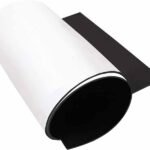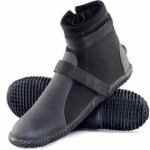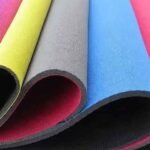Have you ever ended a day of fishing or kayaking only to find your neoprene boots still damp and uncomfortable? Wet neoprene boots can lead to cold, soggy feet, reducing your enjoyment and performance in water activities. Properly drying your neoprene boots is essential to maintain their functionality and extend their lifespan.
Proper drying of neoprene boots ensures they remain flexible, waterproof, and ready for your next adventure.
I remember returning from a long day on the river with my neoprene boots soaking wet. The next morning, they felt stiff and uncomfortable, making it hard to get back on the water. This experience highlighted the importance of knowing how to properly dry and care for my neoprene boots.
Let’s explore effective methods to dry neoprene boots quickly and correctly, ensuring they stay in top condition for all your water-based activities.
Are Neoprene Boots and Why Is Proper Drying Important?
What exactly are neoprene boots, and why is proper drying crucial for them? Neoprene boots are waterproof footwear made from neoprene, a synthetic rubber known for its flexibility and insulation properties. They are commonly used in water sports like surfing, kayaking, and diving to keep your feet dry and warm in wet conditions.
Proper drying of neoprene boots is essential to prevent mold growth, maintain their waterproof qualities, and extend their lifespan.
During a winter kayaking trip, my neoprene boots were exposed to cold, wet conditions for hours. Without proper drying, they developed an unpleasant odor and became less flexible, making them uncomfortable to wear the next day.
Dive Deeper: The Importance of Proper Drying for Neoprene Boots
Preventing Mold and Mildew
Neoprene is susceptible to mold and mildew if not dried thoroughly. Moist environments create the perfect breeding ground for these unwanted microorganisms, which can degrade the material and cause health issues like skin irritation. How to get mold out of neoprene?[1].
Maintaining Flexibility and Fit
Wet neoprene boots can lose their flexibility, making them stiff and difficult to put on. Proper drying ensures that the boots retain their shape and comfort, providing a snug fit for your feet.
Extending Lifespan
Regular and proper drying of neoprene boots helps in preserving the material’s integrity, preventing cracks and tears. This maintenance practice significantly extends the lifespan of your boots, saving you money in the long run.
| Benefit | Description |
|---|---|
| Mold Prevention | Stops mold and mildew growth |
| Flexibility Maintenance | Keeps boots soft and comfortable |
| Longevity | Extends the life of the neoprene material |
Understanding these benefits highlights why proper drying is a critical step in neoprene boot maintenance, ensuring they remain effective and durable for your water activities.
How to Dry Neoprene Boots Fast? Step-by-Step Guide
What is the most effective way to dry neoprene boots quickly without damaging them? Drying neoprene boots properly involves a series of steps that ensure they dry thoroughly while maintaining their shape and flexibility.
Follow a step-by-step guide to dry your neoprene boots quickly and safely, preserving their waterproof qualities and extending their lifespan.
What is the best way to dry neoprene products like boots?[2]
After a long day of surfing, I found that using a combination of air drying and gentle heat sources kept my neoprene boots dry overnight, ready for the next morning’s session.
Dive Deeper: Detailed Step-by-Step Guide to Dry Neoprene Boots
Step 1: Rinse with Fresh Water
Start by rinsing your neoprene boots with fresh water to remove any salt, sand, or debris. This helps prevent residue buildup that can degrade the material over time.
Step 2: Gently Squeeze Out Excess Water
After rinsing, gently squeeze out as much water as possible without wringing or twisting the boots. Excess water can slow down the drying process and cause the boots to lose their shape.
Step 3: Pat Dry with a Towel
Use a clean, dry towel to pat the boots, removing additional moisture. Avoid rubbing, as this can damage the neoprene material.
Step 4: Air Dry in a Well-Ventilated Area
Place the boots in a well-ventilated area away from direct sunlight and heat sources. Natural airflow aids in the drying process without exposing the boots to damaging UV rays or excessive heat.
Step 5: Use a Fan or Dehumidifier
To speed up drying, position a fan near the boots or use a dehumidifier in the drying area. This helps circulate air and remove moisture more efficiently.
Step 6: Stuff with Newspaper (Optional)
For boots that take longer to dry, stuffing them with newspaper can help absorb moisture from the inside. Replace the newspaper periodically until the boots are completely dry.
Step 7: Avoid Direct Heat
Never place neoprene boots on a radiator, stove, or other direct heat sources. High temperatures can cause the neoprene to become brittle and lose its flexibility.
Step 8: Inspect for Dryness
Ensure that both the exterior and interior of the boots are completely dry before storing them. Damp neoprene can lead to mold growth and material degradation.
| Step | Action | Purpose |
|---|---|---|
| Rinse | Remove salt, sand, debris | Prevent residue buildup |
| Squeeze Out Water | Gently remove excess moisture | Speed up drying process |
| Pat Dry | Use a towel to absorb additional moisture | Further reduce moisture |
| Air Dry | Place in a ventilated area away from sunlight | Natural drying without heat damage |
| Use a Fan/Dehumidifier | Enhance air circulation | Accelerate drying process |
| Stuff with Newspaper | Absorb internal moisture | Aid in drying thicker materials |
| Avoid Direct Heat | Prevent damage to neoprene | Maintain material flexibility and integrity |
| Inspect for Dryness | Ensure thorough drying | Prevent mold and material degradation |
Following these steps ensures that your neoprene boots dry quickly and safely, maintaining their functionality and extending their usable life.
What Common Mistakes Should Be Avoided When Drying Neoprene Boots?
What are the typical errors people make when drying neoprene boots, and how can you prevent them? Avoiding common mistakes is crucial to ensure your neoprene boots remain in excellent condition and continue to provide reliable protection and comfort.
Steer clear of common drying mistakes like using direct heat, overstuffing, and neglecting thorough drying to preserve the integrity of your neoprene boots.
Once, I accidentally placed my neoprene boots near a heater, causing the material to warp and lose its flexibility. Learning from this, I adopted safer drying methods to maintain my boots’ quality.
Dive Deeper: Identifying and Preventing Common Drying Mistakes
Using Direct Heat Sources
Placing neoprene boots on or near direct heat sources like radiators, stoves, or hairdryers can cause the material to overheat, leading to warping, shrinking, or brittleness. Always opt for indirect drying methods to protect the neoprene.
Overstuffing with Newspaper
While stuffing boots with newspaper can aid in drying, overstuffing can distort the shape of the boots and cause uneven drying. Use only a moderate amount of newspaper to absorb moisture without compromising the boot’s structure.
Insufficient Air Circulation
Drying neoprene boots in a poorly ventilated area can lead to prolonged drying times and increase the risk of mold and mildew growth. Ensure adequate airflow around the boots to facilitate efficient drying.
Neglecting the Interior
Focusing solely on the exterior of the boots while ignoring the interior can result in incomplete drying. Moisture trapped inside the boots can cause odors and material degradation, so always check both sides.
Using Harsh Cleaning Agents
Using strong detergents or bleach during the cleaning process can weaken the neoprene material, reducing its durability and waterproofing capabilities. Stick to mild soaps specifically designed for neoprene.
Folding or Twisting Boots
Improper handling, such as folding or twisting the boots during drying, can create permanent creases and weaken the material. Always handle neoprene boots gently to maintain their shape and flexibility.
| Common Mistake | Why to Avoid | How to Prevent |
|---|---|---|
| Direct Heat | Causes warping, shrinking, brittleness | Use indirect drying methods |
| Overstuffing | Distorts boot shape, uneven drying | Use a moderate amount of newspaper |
| Poor Air Circulation | Prolongs drying time, promotes mold growth | Ensure good ventilation and airflow |
| Ignoring Interior | Leads to incomplete drying, odors, material damage | Check and dry both exterior and interior |
| Harsh Cleaning Agents | Weakens neoprene, reduces durability | Use mild, neoprene-specific soaps |
| Folding or Twisting | Creates permanent creases, weakens material | Handle boots gently, avoid folding |
By recognizing and avoiding these common mistakes, you can ensure your neoprene boots remain in optimal condition, providing reliable performance and longevity.
How Do You Take Care of Neoprene Boots?
How can you properly maintain your neoprene boots to ensure their longevity and functionality? Taking care of neoprene boots involves regular cleaning, proper drying, and mindful storage practices. These steps help preserve the material’s flexibility, waterproofing, and overall integrity.
Proper maintenance of neoprene boots includes regular cleaning, thorough drying, and correct storage to keep them in top condition and extend their lifespan.[^6]
After several seasons of use, I noticed that my neoprene boots still looked and felt as good as new because I consistently followed a maintenance routine that kept them clean and dry.
Dive Deeper: Comprehensive Care Practices for Neoprene Boots
Regular Cleaning
Regularly clean your neoprene boots after each use to remove dirt, salt, and other contaminants. Use a soft brush or cloth with mild soap and fresh water to gently scrub the surface without damaging the material.
Thorough Drying
As discussed earlier, ensure your boots are completely dry before storing them. This prevents mold growth and maintains the neoprene’s flexibility. Follow the step-by-step drying guide to achieve optimal results.
Proper Storage
Store your neoprene boots in a cool, dry place away from direct sunlight and heat sources. Avoid folding or stacking heavy objects on them, as this can deform the material. Hanging the boots or laying them flat is the best way to maintain their shape.
Inspect for Damage
Regularly inspect your neoprene boots for any signs of wear and tear, such as cracks, holes, or stretched areas. Addressing these issues promptly by repairing or replacing damaged boots can prevent further degradation and ensure your safety.
Use Neoprene Protectants
Applying a neoprene protectant can help maintain the material’s waterproofing and flexibility. These protectants create a barrier against environmental factors, extending the life of your boots.
Avoid Prolonged Exposure to Extreme Conditions
While neoprene is durable, prolonged exposure to extreme temperatures or rough surfaces can cause damage. Limit the use of your boots in harsh conditions and provide proper care to mitigate potential wear.
| Care Practice | Action | Purpose |
|---|---|---|
| Regular Cleaning | Remove dirt and contaminants with mild soap | Prevent material degradation |
| Thorough Drying | Ensure boots are completely dry before storage | Prevent mold growth and maintain flexibility |
| Proper Storage | Store in cool, dry place, avoid folding | Preserve shape and material integrity |
| Inspect for Damage | Check for cracks, holes, and wear | Address issues promptly for safety and longevity |
| Use Protectants | Apply neoprene protectant to maintain waterproofing | Enhance durability and flexibility |
| Avoid Extreme Conditions | Limit use in harsh environments | Reduce material stress and damage |
Implementing these comprehensive care practices ensures that your neoprene boots remain functional, comfortable, and durable for all your water activities.
Conclusion
Properly drying and maintaining your neoprene boots is essential to ensure they remain effective, comfortable, and long-lasting. By following the right drying techniques, avoiding common mistakes, and implementing regular maintenance practices, you can preserve the integrity and functionality of your neoprene boots. Whether you’re engaging in fishing, kayaking, or any other water activity, well-maintained neoprene boots provide reliable protection and comfort, enhancing your overall experience on the water.
At Szoneier, we specialize in manufacturing high-quality neoprene products, including a wide range of neoprene boots designed to meet diverse needs. With our 20 advanced production lines, we ensure that each pair of neoprene boots meets stringent quality standards while offering customizable options to suit your specific requirements. Our neoprene boots are durable, finely textured, soft, highly elastic, shock-resistant, thermally insulating, waterproof, and available in various designs, colors, sizes, and packaging options. We cater to B2B, wholesale, OEM, and ODM models, primarily exporting to Europe, North America, and Australia.
Whether you are a brand owner, wholesaler, importer, or design firm, Szoneier is equipped to provide you with reliable and high-quality neoprene boots that enhance protection, comfort, and brand visibility. Our low minimum order quantities and flexible customization options make it easy for you to get started. Additionally, we offer free samples and color cards to help you make informed decisions.
If you are looking for a dependable partner for your custom neoprene needs, don’t hesitate to reach out to us. Contact us at info@neoprene-bag.com or visit our website www.neoprene-bag.com to request free samples and color cards. Let Szoneier help you create neoprene products that not only meet your protective and comfort requirements but also reflect your brand’s unique identity and values.











